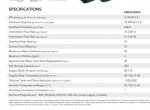My water softener is made by WaterTec which a local Tucson business. They manufacture their own resin tanks and systems but use Clack valves. My unit has a separate 160lbs brine tank (ie, it holds 4 x 40lbs bags of salt). The unit is a 52k grain softener with a GAC filter to remove chlorine/chloramine/VOCs/etc. The regen cycle uses several backwash and rinse steps (to mix up and churn the resin so it doesn’t settle and compact). The brine creation step add about 8 gallons of water to the brine tank and then it sits in there for about 2 hours before drawing the brine solution back into the softener tank to exchange ions. The “brine creation” step is the longest in the process but it’s length ensures that the brine water is completely saturated with salt before it is used to treat the resin. Exchange resins work only when the concentration of the soft ion (Na+) is much, much greater than the mineral ion (Ca++) because the softener resin will have slightly greater affinity for calcium. If your brine solution is not fully saturated, there can be incomplete exchange. There’s a whole spectrum of variables when it comes to ion exchange (media chemistry, brine saturation, temperature, contact volume, pH, etc, etc, etc). All these parameters have to be optimized to get efficient exchange in a reasonable time. As such, different manufacturers will have different process times. Mine is a little over 2 hours.





